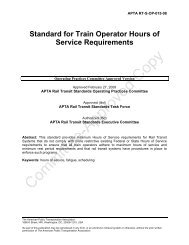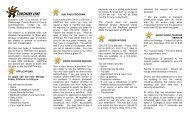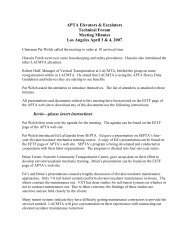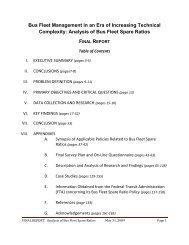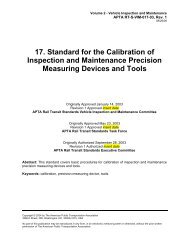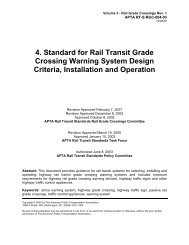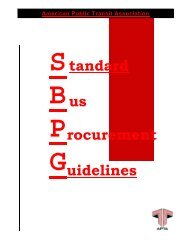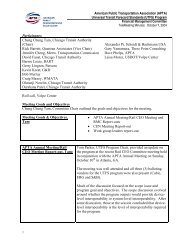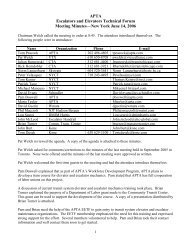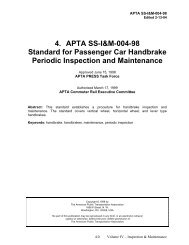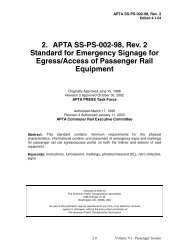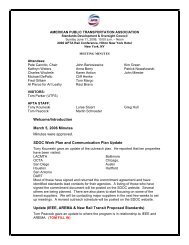Table of Contents - APTAStandards.com
Table of Contents - APTAStandards.com
Table of Contents - APTAStandards.com
Create successful ePaper yourself
Turn your PDF publications into a flip-book with our unique Google optimized e-Paper software.
standard does not mandate the <strong>com</strong>pliance <strong>of</strong> transactions originating from Tier 1<br />
devices. Following are some <strong>of</strong> the disadvantages <strong>of</strong> RIS Part 4.<br />
• Limited support for data elements (objects) not <strong>com</strong>pliant with WP1 data formats<br />
• In a draft form and not implemented<br />
4.9.3 Com mon Message<br />
Structure<br />
RIS messages consist <strong>of</strong> four<br />
parts as shown in Exhibit 4.8-1. The total message length<br />
varies based on the number <strong>of</strong> objects included in Part<br />
3 <strong>of</strong> the message. Each<br />
individual mes sage is iden tified by the “Message Identifier” and contains<br />
the message<br />
specific mandatory and optional data objects as designated by the object<br />
map. The<br />
details <strong>of</strong> these messages have been described in the following sections. 4.9.3.1 PART 1<br />
Exhibit 4.9-1 RIS Message Structure<br />
T he Part 1 consists <strong>of</strong> fixed number <strong>of</strong> fields within each message category described in<br />
Section<br />
4.9.4.<br />
The “Message Identifier” determines type<br />
<strong>of</strong> the message such as “Product Activation”<br />
or<br />
“Use <strong>of</strong> Stored Value”.<br />
4.9.3.2 PART 2<br />
The<br />
Part 2 includes message authentication data represented by the<br />
“AuthenticationDataGroup”. This group contains the data elements that will be<br />
required by the receiver to authenticate the message or series <strong>of</strong> messages.<br />
4.9.3.3<br />
PART 3<br />
Exhibit<br />
4.9-9<br />
AuthenticationDataGroup<br />
MessageAuthCode<br />
MACKeyID<br />
AlgorithmID, optional<br />
MACHashID, optional<br />
This part contains the standard RIS object map and the objects required to be included<br />
in a specific transaction. The purpose <strong>of</strong> the object map is similar to the “bitmap” in<br />
ISO/IEC<br />
8583, as explained in section 4.1.1. The Object Map is an 8 Byte, (64 Bit) binary<br />
Page 67



